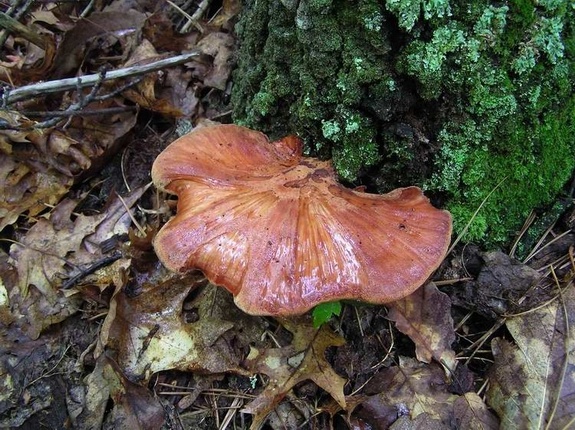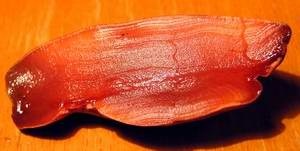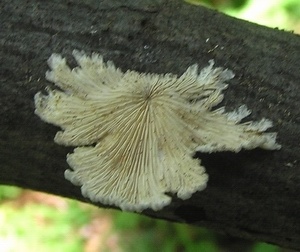|
Return to Hiker's Notebook Home Page
Common Name: Beefsteak Fungus, Beefsteak polypore, Ox tongue - The appearance of the flesh of the fungus is similar to that of a cut of tenderloin beef; the lateral growth from the side of a tree has the general shape and distension of a ox tongue.
Scientific Name: Fistulina hepatica - fistula means "reed" or "pipe" in Latin - a fistula is an anatomical passage leading from one body cavity to another that allows for the passage of fluids; The generic name therefore translates as "small pipes" and refers to the fact that the fungus has crowded but distinct pores on its lower surface for dissemination of reproductive spores from the terminating tubes - Hepaticus is Latin for "of the liver" - used here to indicate that the fungus looks like an animal's liver.
The carnose appearance of F. hepatica affords it an unusually broad acceptability as an edible fungus, even in notably mycophobic Great Britain; it is available in some parts of Europe in markets and as an entr�e in restaurants. When cut, it even exudes sanguineous red juice that complements the thick, veined flesh. It is one of a very few fungi that are considered safe to be eaten raw, though it has a sour, somewhat acidic flavor.
The beefsteak fungus is for the most part saprobic; it lives on dead or decaying organic material, notably broad-leaved trees - preferentially oaks. It is also weakly parasitic; it draws nutrients from live trees, though not with sufficient virulence to kill the tree due to nutrient deprivation. Perhaps ironically, it causes a slow-acting heartwood rot such that the infected wood has an attractive pattern known as "brown oak." Infected trees are sought out by cabinet makers for the unusual patterns of the wood that has an aesthetic appeal for woodworking applications.
The Beefsteak fungus was originally considered to be a member of Polyporaceae,
the Polypore family. It has the physical or structural characteristics that
would taxonomically make this assignment logical: it is a bracket fungus in
having a single lateral attachment to a host tree from which it extends like a
shelf-supporting bracket; it has relatively tough and fibrous flesh; and it
has pores on the underside of the fruiting body - the name polypore means many
pores and refers to this very characteristic of the polypore fungi. However,
recent advances in DNA analysis have contradicted the traditional taxonomy of
fungi based on structure. As is becoming increasingly obvious as more and more
analyses are conducted, the structure of a fungus does not necessarily
indicate its genetic similarity to another fungus. The term clade (from the
Greek klados meaning branch) has fairly recently been adopted to
indicate a group of organisms with similar homologous features derived
The taste of the Beefsteak fungus has been described as tannic and slightly sour. This is not surprising. A chemical analysis revealed that it had five phenolic (aromatic derivatives of benzene) compounds and six organic acids (oxalic, citric, malic, ascorbic, aconitic and fumaric). It was also found to have notable antioxidant effects - it acts as a scavenger for reactive oxygen species and for hydroxyl (OH) radicals. It is also a good source of vitamin C, the ascorbic acid content is noted in the above analysis. In recipes, it is frequently recommended that the Beefsteak fungus be soaked or parboiled to reduce the acidic taste - noting that this also reduces the medicinal and nutritional properties. One popular recipe calls for 600-800 grams (about 1.5 pounds) of Beefsteak fungus to be marinated in white wine with cloves and parsley and then coated with a mixture of flour mixed with a beaten egg , herbs and breadcrumbs. The coated fungus is cooked in olive oil for 2 to 3 minutes until golden brown and then served on a bed of salad. It is called, not surprisingly, herb crusted fungus. |


 from
a common ancestor. It is used to describe a genetic as opposed to a structural
relationship. That is the case with Fistulina hepatica; the pores are
not pores but the ends of closely packed tubes and are functionally much more
like the gills of the umbrella-shaped mushroom than the pores of the polypore.
It is in the Order Agaricales, the gilled field mushrooms. As an example of
the structural dissimilarity of the fungi of the same genetic clade, the
Beefsteak fungus has been placed in the Schizophylloid Clade, exemplified by
Schizophyllum commune, commonly called "split gill"
from
a common ancestor. It is used to describe a genetic as opposed to a structural
relationship. That is the case with Fistulina hepatica; the pores are
not pores but the ends of closely packed tubes and are functionally much more
like the gills of the umbrella-shaped mushroom than the pores of the polypore.
It is in the Order Agaricales, the gilled field mushrooms. As an example of
the structural dissimilarity of the fungi of the same genetic clade, the
Beefsteak fungus has been placed in the Schizophylloid Clade, exemplified by
Schizophyllum commune, commonly called "split gill"